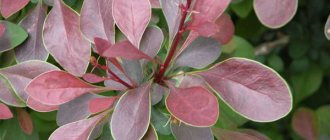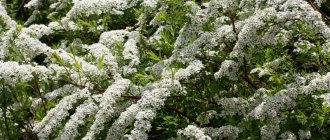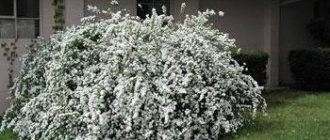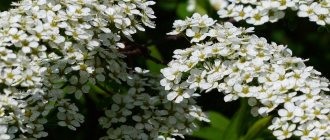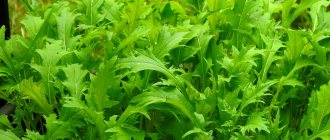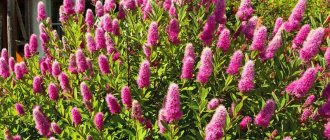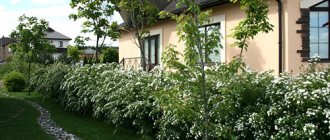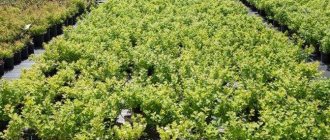Classification of species
Existing species are divided into two groups according to flowering time.
It is worth taking a closer look at the most prominent and popular representatives of them. Important! Spiraea crenate is protected in nature reserves
Spring-flowering
This group contains the following species:
- Gray is a large branched bush, reaching 200 cm in height. Its shoots are felted and ribbed. Covered with gray-green foliage pointed on both sides. It blooms with snow-white flowers, collected in loose shields scattered throughout the shoot. At the top they are sessile, a little lower - on petioles. The flowering period occurs in May, the fruits can be collected in June. The species is a hybrid, so it is not propagated by seeds. Used in bouquet arrangements. It has good winter hardiness.
- Arguta is another tall, spreading plant with a height of 200 cm. It is distinguished by narrow, jagged foliage of a dark green color. Its size is not large - 40 mm. The flowers are snow-white, small, 8 mm in diameter, collected in umbrella inflorescences. The species grows very slowly. Each year it adds 20 cm. Known as the most spectacular spring-flowering species. The flowers cover the branches so abundantly that they bend in an arc under their weight. This gives the bush an unusual appearance. Thanks to this, the plant looks great in landscape design as a single bush, or in combination with other shrubs or as a hedge. Also a hybrid.
- Vangutta - reaches 200 cm in height and girth. Its branches are spreading, beautifully curved downwards. Thanks to this, the crown is cascading. The leaves are serrated, lobed, green on the outside and dull gray on the inside. The shoots are densely dotted with snow-white flowers in hemispherical inflorescences. Flowering lasts several weeks. Sometimes there is a second wave, which occurs in August, but is less abundant. The fruits ripen in October. The species is distinguished by its unpretentiousness and frost resistance. Looks impressive in compositions with pines, spruces, and firs.
- Crenate is a low bush, up to 100 cm, with a loose crown. The leaves are grayish-green, oblong. It stands out among other species by the crenate edge of the leaf plate, which is divided by three veins that clearly appear in the lower part. Spectacular flowers with a yellowish tint sit in wide inflorescences. It can bloom for up to 20 days. The fruits appear in July. This type of spirea produces a lot of root shoots. Because of this, it is not often used in gardening. But in parks, forest parks, and gardens, she is a welcome guest.
Summer flowering
Summer-flowering species are covered with inflorescences on young shoots that appear this year. The next year, the tops of last year's shoots dry out and are replaced by new branches with inflorescences.
Did you know? 1091 Spiraea
-
an asteroid named after the plant genus of the same name.
Representatives of summer species:
- Japanese is a very beautiful bush, formed by tomentose shoots that become bare over time. They are covered with oblong-ovate foliage, the upper side of which is green and the lower side is gray. When it first emerges from the buds, it has a reddish tint. By the deciduous season it acquires a variety of autumn colors. The flowering period extends throughout the summer (45 days). At this time, the bush pleases the eye with pink-red flowers. There are several varieties of this species, the differences between which are in size and flowering: Little Princess, Shirobana, Macrophylla.
- White is an unusual variety of spirea that has a ribbed bush with drooping shoots. They are covered with red-brown bark. The leaves open at the ends of the branches, pointed, 70 mm long. Flowers appear in pyramidal inflorescences. The flowering period occurs in July-August. The fruits ripen in October.
- Birch-leaved - the interesting name of the plant is due to its similarity of foliage to birch. It is a low (60 cm), lush, spherical shrub. The shoots are ribbed and can often be bent in a zigzag. They become covered with leaves in mid-April and lose them at the end of October. At this time it is deep yellow. Spiraea begins to bloom in June. Its inflorescences are dense, formed by a large number of small white, slightly pink flowers.
- Willow is a tall, erect shrub about 200 cm high. Its shoots are covered with red-yellow bark and lanceolate, elongated leaves with a sharp end. The upper part of the leaf blade is dark green, the lower part is slightly lighter. Flowers can be either white or pink. Appear on short peduncles collected in panicles. The bush loves fresh, moist soil. The flowering period begins only in the fourth year of life. They are good for decorating the garden area around the perimeter.
Spirea pests and diseases they cause
Most often, Japanese spirea is affected by spider mites. The disease manifests itself in the appearance of whitish spots on the leaves, their subsequent yellowing and falling off. To destroy mites, it is recommended to treat plants with 0.2% phosphamide or acrex solution. Significant harm can be caused to the plant by aphids and roseate leaf rollers feeding on its juices. In these cases, it is best to treat the bushes with bitoxibacillin and pirimor. You can also use 0.1% actellik or 0.2% ethos. A good effect is obtained by spraying plants in dry weather with water and herbal infusions, strengthening them with regular fertilizing and timely watering.
Powdery mildew of Japanese spirea
Japanese spirea brings bright colors and shapes to the garden plot, allows you to diversify the landscape using unusual topiary figures from trimmed bushes, create a beautiful border or fill the free space with beautiful, eye-catching single specimens of plants. Admiring this decorative crop, you can ensure a positive mood and good health, and bouquets made using its inflorescences will be a wonderful addition to the interior of any room.
conclusions
Spiraea japonica Golden Princess is an excellent plant for decorating a personal plot that can combat air pollution.
Caring for the bush does not require special attention, and the lush and very abundant flowering of fragrant, honey-bearing flowers can attract bees.
If you do not neglect the simple rules for caring for shrubs, you can admire the beautiful creation of generous nature for many years.
Photo examples of beautiful site design with spirea
The Japanese spirea looks most striking in the landscape design in the photo. These include the long-flowering Darts Red, dwarf Albiflora, blooming white, Bullata with wrinkled leaves, frost-resistant Crispa with a ball-shaped crown, Goldflame with golden leaves. Little princess - also planted often, usually singly. It has brown-red shoots, reddish-pink inflorescences, and high winter hardiness. The Grefsheim or gray variety, with drooping branches and snow-white flowers, is popular.
Since spireas are easy to trim, they can be used to create hedges
Living walls can be high or low, depending on the variety chosen
Spiraea combines harmoniously with many garden crops
Japanese spirea feels great on a rocky hill
Summer-blooming spireas look good with roses
Different types of spirea can be combined with each other, creating unique compositions
Spiraea plantings are “lace” hedges along the perimeter of the site, multi-colored alpine slides. Instances with arched drooping branches are planted in open areas, while pyramidal ones are used to create small alleys. The shrub feels great next to quince, apple trees, lilacs, daffodils, hydrangeas, cornflowers, and conifers. Dwarf plants are planted in the form of ridges, borders or alpine hills; varieties with a powerful root system decorate slopes in areas with a slope.
Reasons for the popularity of spirea in landscape design
Today, spirea in landscape design is one of the most popular plants. Benefits of growing shrubs in the garden:
- Great for decorating any style of landscape.
- There are tall (over 2.5 meters) and miniature (15-25 cm) varieties of the plant.
- Suitable for creating “live” hedges, borders, garden compositions, as a tapeworm, etc.
- Blooms beautifully and luxuriantly.
- The plant is represented by varieties that bloom in spring or summer - this is an ideal option for an “ever-blooming” garden.
- Very unpretentious, it is practically not affected by pests.
- This is an excellent honey plant.
In nature, this plant lives in steppes, deserts, and semi-deserts. Shrubs vary in appearance - they are spherical, pyramidal, creeping, erect and others.
Spirea - many advantages and almost complete absence of disadvantages
Plant diseases and pests
One of the main advantages of spirea is its resistance to temperature changes, all kinds of diseases and pests. But this does not mean that she is absolutely protected from this. Most often, spirea is affected by spider mites, which are not affected by most plant treatment products.
Important! When processing spirea (like any other plants), do not forget about protective equipment that will prevent chemicals from entering the respiratory tract, skin and mucous membranes.
If such a problem occurs with seedlings in your garden, be prepared that they will have to be treated with chemicals several times. This should be done when the first symptoms appear (drying, spots on the leaves) until all individuals, as well as the eggs they laid, are completely destroyed. All parts of the plant are sprayed with Acrex or Phosfamide (according to the instructions) or others available in your region.
In addition to mites, the plant is also susceptible to attacks by aphids and roseate leaf rollers. The following drugs can help with this problem: Pirimor, Actellik, bitoxybocillin. To prevent the development of diseases, you can treat the bushes with infusions of herbs and roots (for example, dissected hogweed).
Dwarf spirea (Spiraea x pumilionum Zabel)
Hybrid dwarf spirea, barely reaching 30 cm in height, was obtained by crossing creeping spirea and Hacket. This is a ground cover, creeping plant with elliptical pointed foliage, 1 to 3 cm long. Compared to other related species and varieties, dwarf spirea is quite rare in cultivation, although the plant is unpretentious and very attractive.
White flowers, strewing the bush from June to September, are collected in 5-centimeter corymbose inflorescences. In winter, some of the shoots may freeze, but new branches quickly appear to replace them and are already covered with flowers this year.
Varieties
Japanese meadowsweet has more than 100 different varieties, which differ in the height of the bush, the color of leaves and flowers, crown density, growth rate and other minor features. But their main properties are similar.
Goldmound
This variety is characterized by fairly fast growth. The shrub has a low (up to 60 cm), dense crown. The leaves on the shoots are located close to each other. They are medium in size, oblong in shape. Young foliage has a reddish tint, and a little later it changes to golden, which remains until the end of the season.
Familiarize yourself with the features of growing Goldmound spirea.
The inflorescences of this variety have a very beautiful pale pink color. They appear in June only on the tops of shoots, and decorate the bush until the beginning of autumn. Spiraea variety Goldmound is very light-loving, so it likes to grow in open areas, away from tall trees with a dense crown. To maintain the bright color of the leaves, it constantly needs light, and in large quantities.
Goldmound grows well in fertile, well-drained soils. This shrub is not particularly whimsical, but still prefers slightly acidic and neutral types of soil. It tolerates drought, as well as winter temperature drops, quite steadfastly. Rarely affected by diseases and pests.
This variety is used for decorative purposes, to decorate yards, playgrounds, borders and flower beds. It looks very impressive in group plantings.
Did you know? The name spirea comes from the word “spiral”. Because its shoots grow spirally
.
Japanese Dwarf
This shrub is short, only 30 cm in height, and it grows quite slowly. Over the course of a year, it grows by only 5 cm. It has a beautiful rounded crown with small green leaves. In autumn they change their color to orange.
Starting in June, the bushes are covered with inflorescences, enveloping them in a delicate pink cloud. After flowering, it is recommended to cut them off. Japanese spirea Japanise Dwarf is not picky about growing conditions, but grows better in moist and loose soils. She loves the sun, so she prefers open areas. Used for landscaping alpine hills, borders, and also as a hedge.
Golden Princess
Spiraea dwarf Golden Princess is a small shrub, 50–60 cm high, with a rounded crown and yellow leaves, the shade of which changes depending on the time of year. Every year it grows by 5–10 cm. This variety of spirea blooms in June–July. Its flowers, pink with a reddish tint, are collected in corymbs. Unlike the inflorescences of the Japanese Dwarf variety, they are rarer.
This decorative variety is used in group and individual plantings, as a ground cover, to create alpine slides, as well as for low borders.
This variety, like the others, loves fertile soils, loose and fairly moist. Prefers well-lit places. Normally tolerates low temperatures and short-term forced drought. It is recommended to prune the shoots of Golden Princesses in the spring, and dry inflorescences should be removed at the end of summer.
Candlelight
Spiraea dwarf Candlelight is up to 50 cm high, and every year it grows by about 5 cm. Its leaves are orange-red at the time of blooming in the fall, and become bright yellow in the summer. Flowers appear in June and bloom until early September. They are collected in inflorescences and have a bright pink color. After flowering, it is advisable to cut them off.
Candlelight loves sun or light shade. Grows well in rich, loose soils with a neutral acidity level. It tolerates winter easily and does not need shelter. Used for group and individual landscaping to create an attractive landscape.
Also learn about the types of spirea that bloom pink.
Care
- When planting spirea, it is necessary to take into account that the shrub quickly grows with basal shoots, significantly increasing the occupied area. Therefore, it is better to allocate a sufficiently spacious area for planting in advance.
- Spiraea should be watered sparingly. In the summer heat, two buckets of water are allocated for each bush every two weeks. To do this, the water is left to bask in the sun, transferring watering to the evening.
- The tree trunk circle must be loosened and mulched, removing weeds in a timely manner. Peat, compost or sawdust are suitable as mulch.
- For more luxuriant flowering, you need to cut off dry inflorescences without leaving them on the bush.
- Prune growing green shoots, cutting them off near the very base of the bush.
Spiraea is a frost-resistant plant, but before the onset of winter cold, it is better to cover the trunk circle with a layer of mulch from dry leaves.
Top dressing
To get really abundant flowering of the bush, you must not neglect fertilizing. Liquid fertilizer is suitable for this purpose. Fertilizing is carried out twice a year.
- The first feeding is in the spring, immediately after pruning. To do this, you can use complex fertilizer.
- The second is during the summer flowering period of the bushes. In this case, organic matter is used with the addition of superphosphate. To do this, you can prepare a solution from mullein (one and a half liters per bucket of water), adding 10 g of superphosphate. If you feed with chicken droppings, then add half a liter to the bucket.
You should not neglect soil mulching, which promotes better air penetration to the roots. After all, the earthworms living there perfectly loosen the soil.
Trimming
Pruning is carried out at the very beginning of spring, before the sap begins to flow. Remove dry and damaged stems. Branches are pruned with garden pruning shears to the level of the first large bud. The stems grow very quickly, so there is no need to spare every branch. Pruning will promote better flowering and give the bush a more attractive appearance.
Adult bushes are pruned to a height of 30 centimeters.
Spiraea japonica Anthony Waterer | Online store of garden plants
Description Japanese Spiraea Anthony Waterer. This is a small shrub 0.6-1 m high, 0.6-0.8 wide. The crown is compact, dome-shaped, formed by vertically growing or slightly hanging shoots. The flowers are carmine, collected in corymbose inflorescences up to 15 cm in diameter. Flowering is abundant and long lasting from late June to September.
The leaves are lanceolate, have a reddish tint when blooming, later bright green, individual leaves have yellow or pink veins. In autumn, the leaves become brightly colored from orange to brick red. Winter hardiness zone: 5 (-29 °C)
Place for planting Spiraea. A well-lit or slightly shaded area is suitable for planting. It is undemanding to soil fertility, but grows more luxuriantly in rich soils. The minimum groundwater level is 1.5 m.
Spirea planting. The optimal time for planting is September, preferably in rainy or cloudy weather. The planting distance is from 0.5 to 1.0 m, in a hedge 0.4-0.5 m in a row and 0.3-0.4 m between rows.
The size of the planting hole should be 25–30% larger than the size of the plant’s root system, and there must be a drainage layer at the bottom. Planting depth 40 - 50 cm. Root collar at ground level. Requires drainage from broken bricks and sand.
Spirea care.
In early spring, plants are fed with complete mineral fertilizer, and pruning is also carried out to maintain the decorative appearance of the crown. At the same time, the branches are shortened to well-developed soil, cutting off all small shoots.
note
As flowers fade, you can remove the inflorescences, but this is not necessary. Occasionally, radical anti-aging pruning is carried out.
Reproduction of Spiraea. Spiraea is propagated by seeds, spring and summer cuttings, and layering. All types of spirea can be propagated by seeds, with the exception of hybrids; they are propagated only vegetatively.
Using spirea in garden design. Spiraea birch leaf is used for group and mixed plantings, for creating hedges, borders and lining tall shrubs.
We store plants ready for shipment in special conditions. We pack parcels in a secure manner. We notify you about shipment and control the parcel en route.
We work on a 100% prepayment basis in order to reserve the best varieties for you and guarantee on-time delivery without postage or commissions.
Here you can buy various planting materials: seedlings of roses, fruit and ornamental trees and shrubs, all groups of conifers, standard species, rhizomes of perennial flowers, bulbous plants for autumn and spring planting, lawn grass seeds, fertilizers and pest control products.
Proper planting of Japanese spirea
Japanese spirea is considered not a picky plant, however, for its good rooting and further development, the following planting order must be observed:
- Observe the time for planting the plant in open ground. This is best done in early spring, before the buds on the trees swell. But if for some reason it was not possible to plant spirea in the spring, it can also be planted in the fall. A shrub planted in autumn must be protected from cold winds and severe frosts;
- Choose a landing site that should be well illuminated by sunlight for at least four hours a day. The composition of the soil for spirea is not of great importance, however, the more fertile it is, the better the plant develops and the richer it blooms;
- Carefully examine the root system of the purchased seedlings. If there are rotten or dry roots, they need to be cut off, and healthy ones should be shortened to thirty centimeters;
- Purchased seedlings in a container must be filled with plenty of water, this is done so that the root system of the plant is not damaged when removed from the container. If the earth ball enveloping the root is very dry, then it must be soaked in water for several hours;
- When planting in groups, you need to take into account that the roots of bush spirea grow greatly. In this regard, it is necessary to maintain a distance between seedlings of at least fifty centimeters;
- The planting hole must be dug with steep walls, and its volume must exceed the size of the root system by at least a third;
- The dug hole must be left empty for two days. Then fill its bottom with small wild stones and fill it with soil of the required composition;
- It is necessary to plant spirea with extreme caution, carefully straightening the root system. The root neck should be located on the same plane with the surface;
By fulfilling all the requirements for planting spirea, even an inexperienced gardener will be able to grow a healthy and beautifully flowering bush plant.
Application in landscape design
Spiraea is often used in landscape design. A dense flower cover adorns the bush for several months.
Even after flowering has finished, it attracts attention with the contrast of scarlet, yellow and green leaves. Some tips for decorating your garden with Japanese spirea:
- For solo planting, you should choose varieties with a spherical crown or with long, flowing shoots, for example, Vangutta. Shrubs with bright flowers are placed as a color accent in the composition.
- Contrasting group plantings that combine shrubs of different shapes, widths and heights look beautiful.
- It is necessary to combine plant varieties in a group so that at least several of them bloom at any time during the summer season.
- Tall varieties of Japanese spirea are suitable for Asian-style landscape design.
- Varieties of Japanese spirea are well suited for creating a contrast of textures, for example, alternating small shrubs with stones and thuja.
- Shrubs are combined with any wooden structures: fences, bridges, swings, flower beds.
- Modern landscape designers often use mixborders that combine plants of different shapes and shades. The best neighbors of garden flowers: tulips, daffodils, irises, roses, daylilies.
- Complementary trees: pines, spruces, junipers, broom, multi-flowered oleaster.
Important! Spiraea is suitable for any landscape design: borders, alleys, massifs, rock gardens, rockeries
How to plant?
Planting spirea begins with choosing a suitable location. The plant loves a lot of sunlight, but it is better to prefer openwork shade. It is such a place that will allow the leaves to acquire an attractive brightness, and the flowers to be abundant and lush. The shrub does not like drafts, groundwater, or lowlands. Loose soils, preferably acidic, suit it best.
Before planting, the soil is well dug up while weeds and roots are removed. Planting of seedlings is carried out in holes or on a finished border. A couple of weeks before planting, depressions up to 0.5 meters deep are prepared. A drainage made of pebbles or broken bricks is placed at the bottom. Then a nutrient mixture of soil, humus, peat and sand is placed in the hole, which must be well watered for planting.
In the center of the resulting place you should make a mound on which the spirea will be planted
When planting, it is important to straighten the roots and sprinkle them with soil. Then you need to pour about 3-4 liters of warm water under each seedling.
Sprinkle a small layer of mulch (sawdust, grass clippings) onto the surface to retain moisture.
Preparing a seedling for planting
To plant Japanese spirea in your garden plot, you need to purchase a healthy and well-developed seedling. To do this, the purchased plant must be:
- with closed roots, that is, the root system was in a container or a large lump of earth;
- compact and young, there should be no leaves on it. Since shrubs with leaves do not take root well;
- with a well-developed root system. In this case, the roots should be elastic and moist, without dry or broken ends;
- with living and flexible branches;
- with healthy kidneys.
Read also: Pepper Winnie the Pooh: description, photos, reviews
After the required seedling has been purchased, it must be prepared for planting. To do this, do the following:
- all damaged parts of the root system are removed;
- Too long roots are shortened so that their length does not exceed thirty centimeters. This process is best carried out using a sharp blade;
- the upper part of the seedling is shortened;
- The roots are placed in water for several days.
Feeding and reproduction
Ornamental shrubs should be fed after pruning in mid-summer, and the soil should also be mulched annually with peat or crushed bark.
It is necessary to maintain moderate watering, increasing it only during periods of active drought. Young plants need more abundant watering, but for older plants it can be reduced. Young spirea also respond well to loosening the soil.
Spiraea bushes are best propagated by cuttings or layering. The plant is cut in summer, starting in mid-June. The shoot is planted in a mixture of equal proportions of sand and peat and sprayed generously several times a day to maintain an increased level of humidity.
It is necessary to provide the cuttings with regular good watering, and then by autumn they will transform into independent bushes.
Growing and caring for the plant
To enjoy the beauty of spirea, it is important to properly organize planting and further care for the plant.
Conditions of detention
The plant loves open ground, but it needs to be planted in the spring before the buds begin to bloom. A rainy or cloudy evening is best for this. Spiraea needs more light for good development, although it feels good in partial shade.
Soil and fertilizers
Spiraea is capable of growing on poor soils, but in this case it will not be able to demonstrate all its beauty. Optimal for it are loose, airtight soils filled with humus. Soil acidity is suitable at a level of 5.6-7.8 pH. It is important to make a 15-20 cm drainage layer when planting; brick chips are suitable for this. For primary feeding, take deciduous soil or turf, sand, peat in a ratio of 2:1:1.
Further, as you grow, it is advisable to use:
- complex feeding after cutting the bush;
- solution of mullein with superphosphate (10 g per 10 liters of liquid) closer to July.
Watering and humidity
The first watering is carried out when planting the bush: 1-2 buckets of water at a time. Due to the underdeveloped root system, spirea is undesirable to experience drought, so proper watering is important in hot weather: 15 liters of water twice a month per bush. During periods of moderate temperatures, you should not actively water the plant. But carry out weeding and loosening regularly to ensure constant access of oxygen to weak roots.
Relation to temperature
Spiraea tolerates both heat and cold without difficulty, because in natural conditions it grows in rather harsh conditions.
Plant propagation and planting
Spiraea can be propagated in three ways:
- seeds;
- layering;
- cuttings.
Growing from seeds
Let us immediately make a reservation that this method is not suitable for hybrid varieties due to genetic characteristics.
Reproduction of spirea by seeds proceeds according to the following scheme:
- Take the seed.
- Prepare wide containers with low walls.
- Fill them with a mixture of peat and deciduous soil.
- We place the seeds on the workpiece and cover it with 1 cm of peat or sprinkle it with earth.
- In a week or a week and a half we expect the first shoots to appear.
- They need to be taken care of and treated with phytosporin, foundationazole or any other antifungal drug.
- 2-3 months after germination, the seedlings are ready for planting in open ground in light partial shade.
- Be sure to pinch the small roots.
- We water the planted shoots and mulch with peat.
Specimens obtained from seeds will delight you with color only in the 3rd or 4th year of growth.
Reproduction by layering
This method should be used in the spring. We press low-lying shoots to the ground into pre-made recesses and secure them so that the branch does not return to its original position. The tip of the future seedling is cut off and sprinkled with earth along its entire length. For the winter, do not forget to hide the cuttings well under a warming blanket of leaves. By the very first spring, the shoot will take root and can be planted in the right place.
The principle of propagation of a bush by layering/
Decorative varieties of Japanese spirea: features and disadvantages
Japanese spirea, as the name suggests, was brought to us from Japan, but it is also grown in China. A beautiful shrub with tomentose-pubescent shoots, oblong succulent leaves, green at the top and bluish below, which by autumn are colored in various shades of red-orange. Flowering continues up to 50 days a year. This type of spirea has many varieties that differ in the intensity of color and flowering, height, and crown shape. In our country, the following varieties are considered the most common.
Japanese spirea variety "Little Princess"
The plant forms a neat bush up to 60 cm in height, with a rounded compact crown, blue-green foliage in the shape of an elongated ellipse. The flowers are pink in color, collected in a scale inflorescence. Flowering occurs in early to mid-summer. The growth of the bush is slow. It looks great both in a single planting and when landscaping forest edges, creating shrub groups, and in hedges. Among the disadvantages of the variety, one can note the rapid loss of shade intensity in flowers, which can fade in the bright sun.
Japanese spirea variety "Shirobana"
Shrub reaching a height of 80cm. With dark green narrow lanceolate leaves, about 2.5 cm in length. The color of the flowers of this variety can be white or bright pink, and sometimes even red. It all depends on how lit the place where the bush grows is. It blooms in July and produces abundant new flower stalks until mid-August. This variety can be used to diversify rock gardens, low borders, compositions of conifers or other shrubs. The disadvantage of this variety is that the bush is untidy; without pruning, the spirea forms a crown chaotically.
Japanese spirea variety "Albiflora"
She is also a white spirea. The height of the bush is 60 cm, and the flowers themselves are snow-white, which is very unusual for spireas that bloom in the summer. During flowering, an indescribable, thick and rich aroma hovers over the bush. The foliage of the plant is green, oval-shaped, and against its background the white inflorescences look especially stunning. However, when the flower fades, it acquires a brownish-withered hue, so such flower stalks must be removed in a timely manner.
Japanese spirea variety "Golden Princess"
An interesting shrub, reaching a height of 50-60cm, the crown diameter range is 1 m and a little more. In the spring, the foliage acquires a bright yellow tint, in the summer it becomes lighter, and in the fall the leaves become orange, with soft undertones. The leaf is 7-8 cm long. Flowering is profuse and begins in June. The flowers themselves are pink or red-pink, collected in a scale inflorescence, which can be up to 5 cm in diameter. The plant attracts many insects, so it is not recommended to plant it in places for walking and children's recreation.
Spiraea is often used as an ornamental ground cover that gets along well with other low-growing plants, such as cinquefoil, lavender, St. John's wort, rudbeckia, yarrow and field grasses. Recently, this shrub can be found not only in private gardens, but also in city parks.
Planting and care
In this article we will look at the intricacies of planting and caring for summer-blooming spirea, which includes the Golden Princess spirea.
First of all, about the landing time. Summer-blooming meadowsweet species are planted in the spring. When preparing a seedling for planting, be sure to soak a lump of soil in which the roots are covered (this is how planting material is usually sold). For this, plants choose sunny places, with light and fertile soils. Spiraea should not be planted in lowlands - the shrub does not like stagnant water. A good drainage layer must be provided in the planting hole (a layer of crushed stone, expanded clay or brick chips is poured onto the bottom). A certain amount of peat and sand is added to the soil that is intended for sprinkling the seedlings. When planting, the seedling is compacted, watered well (10-15 liters of water should be used per bush) and the root zone is covered with a layer of sawdust, peat or compost.
Spiraea Gold Princess is a moisture-loving plant and requires constant watering. The bushes are watered abundantly immediately after planting and for the immediate future - this is necessary for their better survival.
In order for meadowsweet to enjoy lush flowering for a long time, it is fed with organic and mineral fertilizers. As a good top dressing, use an infusion of mullein and chicken manure, which is prepared according to generally accepted instructions. It is also acceptable to use standard complex fertilizers for garden plants. The plant is fed twice: after spring pruning and in the summer, in the second decade of June. Plants begin to be fed only in the third year of growth.
Any meadowsweet tolerates pruning well. But the time for this procedure is determined by whether the shrub belongs to spring or summer flowering.
Summer-blooming spireas are pruned in early spring. Bushes begin to be pruned only when they reach 2 years of age. During this procedure, old branches and those that have deviated strongly to the ground, are sick or frozen are cut out. Timely and correct pruning of the bush allows you to form a crown and rejuvenates the plant.
Spiraea can be propagated using layering, seeds, dividing the bush or cuttings.
The simplest and most effective method is propagation by layering. To obtain a layer, you need to bend the shoot to the ground and fix it by sprinkling it with soil. Future cuttings are watered regularly. In the autumn or spring of next year, the rooted shoot is separated from the parent plant and planted in a permanent place of growth.
Propagation of meadowsweet by cuttings also gives good results, although the method is considered more labor-intensive. Summer-blooming spirea are cut in July, after flowering has ended. Cuttings can be cut from either green or partially lignified shoots. The branches are planted in a sand-peat mixture and cared for according to the standard scheme. Seedlings from cuttings are planted in a permanent place of growth the following spring.
The most difficult way to propagate spirea is from seeds. Its effectiveness is not high due to the low germination of seed material. Sown seeds and small seedlings require constant and careful care. A bush obtained in this way can bloom only in the 4th or 5th year of growth.
Spiraea Golden Princess, like all varieties of Japanese spirea, is not a winter-hardy variety and requires obligatory shelter for the winter. To do this, the shoots of the bush are bent to the surface of the earth and covered with suitable material.
Spiraea very rarely gets sick and is affected by pests. Among insects, it is afraid of invasions of aphids and spider mites. Occasionally affected by fungal diseases.
It is not for nothing that Japanese spirea is considered an unpretentious plant. By following simple rules of cultivation and care, any gardener can achieve this wonderful garden decoration.
Reproduction of spirea
There are three ways to propagate spirea: seed, layering, and cuttings. More details about each below.
From seeds
This method is extremely rarely applicable, since it is very difficult to collect the seeds, and besides, their germination rate is very low. In addition, you need to wait a long time until the plant is ready to bear fruit.
Important! If you still decide on this method of propagation, choose non-hybrid varieties. The germination rate of their seeds is 75–80%. For propagation you need:
To reproduce you need:
- Wait until the seed pods form and ripen (turn brown).
- Have time to collect the seed before the fruit opens.
- Place to ripen in a warm place for 14 days.
- Sowing is carried out in early spring, like ordinary seedlings, under a film.
- Classic care: watering, fertilizing with minerals, loosening.
- At the end of summer, with the appearance of the second true leaves, you can plant the seedlings into the ground.
- In the cold season, cover the bed with spruce branches, leaves and sprinkle plenty of snow.
- With the arrival of spring, plant it in a permanent place.
By layering
The properties of the plant are such that it is best to propagate it by layering. Getting them is not difficult.
Important! It is advisable to choose the longest branch to get as many young as possible. Here is a detailed description of the actions:
Here is a detailed description of the actions:
- Select a young bush (2-3 years old) and highlight a young shoot with blossoming foliage on it. It is most convenient for this to be the outermost branch.
- Carefully scratch the shoot with a sharp knife in the place where it will come into contact with the ground.
- Bend the branch to the soil, dig a ditch under it and place it in it.
- Water thoroughly, secure with a wire staple and cover with soil.
- In spring and summer, regularly carry out irrigation procedures and add nutrients.
- In the fall, a seedling should appear that can be moved to a permanent location. To make the roots stronger, replanting can be done in the spring.
Cuttings
Propagation from cuttings is a little more difficult. Difficulties are associated with the need to carefully and continuously care for planting material. But this method allows gardeners to obtain an exact copy of the mother plant with full preservation of its characteristics. The collection of cuttings from spring varieties is carried out in early July, and from summer varieties - at the end of this month.
Did you know? The Latin name spirea (Spiraea) comes from the ancient Greek
"
σπειρα
"
which means
"
spiral
"
.
Description of the procedure:
- You need to choose an annual branch that is partially lignified.
- It must be cut into pieces so that each contains 5 leaves.
- Its lower edge is freed from foliage, and the rest is cut in half.
- A container with a biostimulator is prepared, into which future plants are immersed with the lower end for 10–12 hours.
- Then the cut at this end is treated with a root-forming mixture.
- The box is filled with fertile soil mixed with sand.
- Cuttings are planted in it and watered abundantly.
- Each branch is covered with a glass cap or a film is stretched over the entire box.
- Future spirea are located in partial shade outdoors. It is best to place it under a spreading tree.
- The soil needs to be kept moist throughout the summer. To do this, the cuttings are sprayed 2-3 times a day with water.
- Before cold weather, the box is dug into the ground, mulched with leaves and covered with a wooden box.
- After the snow melts, the box is removed. With the appearance of young shoots, the seedlings can be planted in a permanent place.
An unusual perennial shrub perfectly decorates park areas and adds zest to the landscape design of personal plots. It is easy to care for, it tolerates cold winters well, so it can be used for decorative purposes in any climate zone.
Spiraea Golden Princess - planting rules (photo)
The main advantage for which spirea is valued is its resistance to frost and cold. The plant is not afraid of frost, therefore it is adapted to the climatic conditions of our country. Where to get planting material? Japanese spirea is planted using seedlings, which are best purchased in specialized stores. You should not trust spontaneous markets, since you are unlikely to be able to find high-quality seedlings there.
Spiraea seedling
Spireas are planted in late autumn, after all the leaves have fallen, or in early spring, before the sun gets too hot.
Planting spirea is not a difficult task, but certain conditions must be met:
- The soil. The soil should be nutritious and loose. Under no circumstances should you plant spirea in acidic soil. To create the optimal composition of the soil, it is necessary to mix garden soil, humus, peat and sand. It is also recommended to place a small drainage system in the form of expanded clay or large crushed stone at the bottom of the hole.
- Location. Golden Princess needs constant sunlight and does not tolerate shade very well. It is better to choose the most optimal place for the plant - on the rise or away from lushly growing trees or shrubs.
- Pit size. The volume of the hole in which the spirea will be planted should be one third greater than the size of the plant’s root system. Each seedling is planted separately in each hole and compacted tightly with soil.
Important! Very soon the Japanese spirea will take root and produce basal shoots. This means that the area in which the shrub was planted will begin to increase significantly. Therefore, try to plant the plant in free areas, with enough extra space.
Do not forget that the root collar of the plant must remain level with the ground. After planting, it is necessary to compact the soil tightly and water the seedling abundantly.
Planting and caring for the Japanese Golden Princess spirea
Japanese meadowsweet is considered an unpretentious species, but the development of any plant depends on proper planting and care. Rooting will occur faster if the gardener follows the rules for caring for the Golden Princess spirea after planting.
Preparation of planting material and site
Proper planting involves choosing a place with suitable conditions for the plant, preparing seedlings and accurately implementing the algorithm. The optimal time for planting Golden Princess is spring. It is during this period that summer-flowering spireas are planted. Some recommendations:
- Meet deadlines. The bushes need to be planted before the buds swell. If the deadline in the spring is missed, then you can plant Golden Princess spirea in the fall, when the leaf fall ends.
The planting technology will not cause any difficulties.
Planting spirea Golden Princess
Planting seedlings begins with preparing holes. You need to dig a hole with vertical walls. The size of the hole should be 1/3 larger than the root system. Leave the finished pit without soil for 2 days. Leave a distance of at least 50 cm between two planting holes.
Then lay a drainage layer on the bottom. Expanded clay, crushed stone, broken brick are suitable.
Prepare a nutrient mixture from garden soil, peat, sand. Mix all components in equal quantities.
Spread the roots of the Japanese spirea seedling, place the plant at the bottom of the hole, and sprinkle with soil. The root collar should be at ground level.
Compact the tree trunk circle and water well. Then lay a layer of mulch.
Watering and fertilizing
Among the list of measures for caring for the Japanese Golden Princess spirea, watering and fertilizing are the main ones.
You need to water the bush in a timely manner, but moderately. In the hot summer, it requires watering twice a month. 20 liters of water are poured onto one plant. It will be good if it is heated in the sun.
Fertilizing improves the flowering of spirea. Liquid fertilizers are suitable for Golden Princess. In the spring, feed the bushes with complex fertilizer after pruning. The second time nutrition is introduced during the flowering period (second decade of June). Now organic matter is bred - chicken manure (1:18), mullein (1:6). Additionally, mix 10 g of superphosphate for each bucket of water. They begin to feed spirea after 2 years of age.
How and when to prune Golden Princess spirea
The variety tolerates pruning and shearing well. For summer-blooming spirea, spring pruning is recommended. It consists in shortening the shoots. 20 cm of shoot length is left above the ground surface. Basic pruning requirements for the formation and rejuvenation of a bush:
- First cut out all branches that are sick, dry, frozen, too inclined to the ground or very weak.
- Shorten last year's shoots and remaining branches to the first large buds.
Gardeners need to remember that when pruning, they should not spare older branches. Japanese meadowsweet grows best when carefully pruned. Otherwise, in the summer they will dry out and spoil the exterior.
Gardeners do not practice autumn pruning of the Japanese Golden Princess spirea.
Description of spirea
There are about ninety species of spirea in the genus, which have the following differences among themselves:
- In shape and height;
- Flowering time;
- Arrangement of flowers.
The Golden Princess variety of spirea is the most popular among summer residents and landscape designers.
The plant begins to bloom in summer. Flower formation occurs on young shoots. Spiraea grows and develops within seven days; this is a long period of time during which an active growth spurt occurs. The tallest spirea of this variety reaches seventy centimeters in height.


